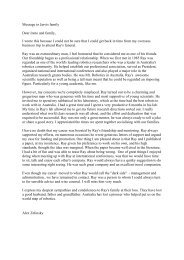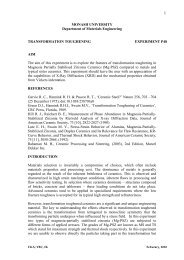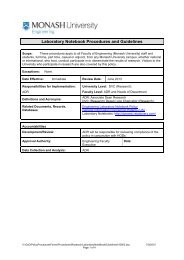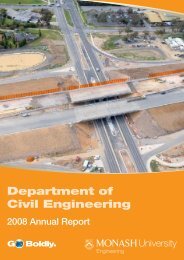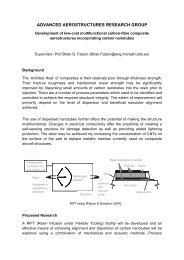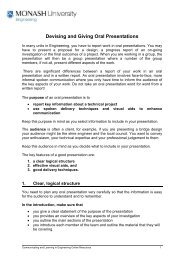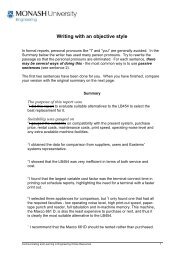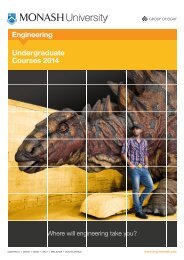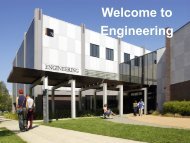4th year Project: Research Proposal
4th year Project: Research Proposal
4th year Project: Research Proposal
Create successful ePaper yourself
Turn your PDF publications into a flip-book with our unique Google optimized e-Paper software.
<strong>4th</strong> <strong>year</strong> <strong>Project</strong>s: Overview<br />
The <strong>4th</strong> <strong>year</strong> research project provides students with a challenging opportunity to<br />
plan, undertake and report on a limited program of independent research into a real<br />
Engineering problem. The project can involve different tasks including a review of the<br />
literature, laboratory experimentation, analytical work, numerical simulations, and<br />
industrial involvement. The project can also involve the development of a design and<br />
presentation of a prototype.<br />
Different departments have different requirements for the projects, so that the<br />
guidelines presented in these resources are general in nature. You must always<br />
check the particular requirements of your department so that you can then apply<br />
these guidelines successfully.<br />
<strong>4th</strong> <strong>year</strong> <strong>Project</strong>s: <strong>Project</strong> <strong>Proposal</strong><br />
Requirements<br />
The length of the <strong>Project</strong> <strong>Proposal</strong> varies from department to department. For<br />
example, in Mechanical Engineering the proposal is approximately 800 words or 2 A4<br />
pages, while in Civil Engineering the proposal is about 3 pages long.<br />
In Electrical Engineering, you do not write a research proposal. Instead you present a<br />
plan of your design in a written Requirements Analysis and Design document to<br />
describe the scope of your project and the items to be delivered.<br />
Guidelines<br />
The purpose of the proposal is:<br />
• to explain the need for the project, and<br />
• to plan the project. Often this can help to identify any potential problems you<br />
may have in carrying out the work, and you can then develop contingency<br />
plans.<br />
In your proposal, you need to answer the following questions:<br />
Communicating and Learning in Engineering Online Resources 1
- Why undertake the project? Students should be able to explain the relevance<br />
of the work and how it relates to research/practice needs in the discipline.<br />
- What will be the scope of the project? Students should be able to develop a<br />
concise statement of the specific aims/objectives of the work.<br />
- How will the project be undertaken? Students should be able to describe the<br />
main tasks to be undertaken and identify the resources required to complete the<br />
project.<br />
- When will the work be undertaken? Students should be able to develop a work<br />
plan for the project which identifies the timing for each primary task.<br />
In any proposal, you always have to consider your particular project in order to<br />
decide for yourself what is the best way to organise your information into logical<br />
sections and then to devise appropriate headings for these sections in your proposal.<br />
Typical sections in a proposal and their contents are outlined below.<br />
Title - provides a concise, accurate and informative title which immediately orientates<br />
your reader to the focus of your project.<br />
Introduction – explains why you are doing the project. It provides a brief overview<br />
of the background to the project and establishes a particular area, or problem, that<br />
needs to be investigated further. It provides a clear statement of the topic of the<br />
proposed work.<br />
Aims - clearly states the aims of the study (to measure, to devise, to design, to<br />
establish, to identify, etc). If there is a general aim, try to establish a number of<br />
specific aims as well. Aims can also be incorporated in the Introduction.<br />
Methodology - outlines how the project will be undertaken (by conducting a series<br />
of experiments; by developing a model; by conducting a survey of engineering<br />
practice; by reading and critically reviewing a number of research papers; by doing<br />
fieldwork; etc).<br />
<strong>Project</strong> Plan – describes what you will do. It is a plan of the tasks which will enable<br />
you to achieve the stated aims of your project. To devise a plan, you need to break<br />
the project down into a series of steps or stages, and you then outline the tasks<br />
within each stage (for example, In stage 1, I will devise a survey which…..; carry out<br />
the preliminary experiments; design the …….. In Stage 2, I will interview three<br />
engineers; carry out further experiments; build the ….). If possible, you could also<br />
identify concrete outcomes for each stage of the project (eg, Outcomes of stage 1<br />
Communicating and Learning in Engineering Online Resources 2
are a series of graphs showing ……The outcome of stage 2 is a brief review of the<br />
research papers on ...…. . Outcomes of stage 3 are the collection and analysis of<br />
data on the effect of …...). Try to provide as much detail as possible in your plan as<br />
this planning should help you to carry out the project work more effectively and<br />
efficiently.<br />
The project plan should also include a timetable in which you plan the timing for the<br />
main tasks. This timetable can help to keep you on track throughout the project. The<br />
plan may also include a list of the resources required to do the project.<br />
Potential contributions of the proposed project - summarises, perhaps in point<br />
form, the main areas where your project will make a contribution. Examples of<br />
potential contributions are: The study will provide an estimation of ……;<br />
recommendations for …..; an understanding of ….; an improved design for…;<br />
further knowledge of …...<br />
Appendices - provide more detailed information than required in the proposal such<br />
as details of equipment specifications, pilot study data or research design or<br />
analytical models to be used. You may not need to have any appendices in your<br />
<strong>Project</strong> <strong>Proposal</strong>.<br />
Communicating and Learning in Engineering Online Resources 3



